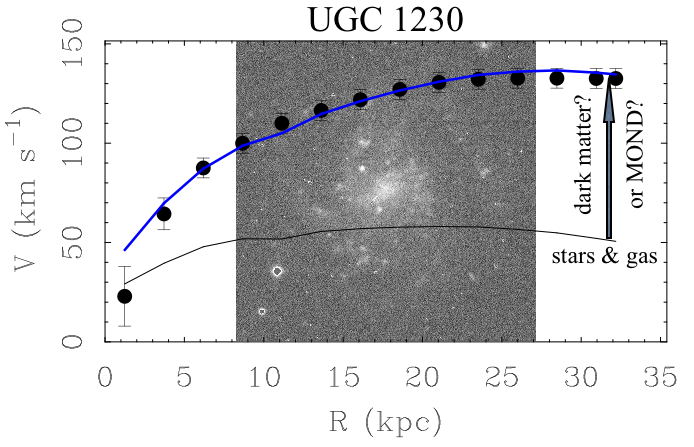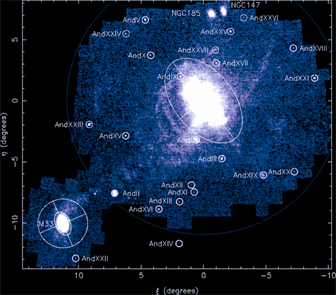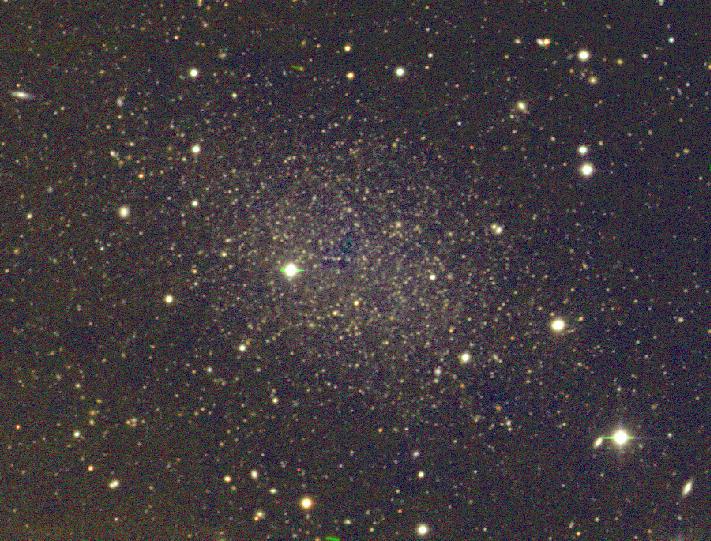Predicting the Speeds of Stars in the Dwarf Satellite Galaxies of Andromeda:
Dark Matter or Modified Gravity?
It is has long been known that what you see is not what you get.
Cosmically speaking, that is. When astronomers apply the known
law of gravity to galaxies and other large systems, things don't
add up. The visible stars and gas fall short of explaining
the observed motions.
Perhaps the most famous example of this phenomenon
is how the rotation curves of galaxies
tend to flatten out when Newton's Laws say they should be declining.
In order to explain the extra velocity, it is conventional to invoke
a vast halo of invisible dark matter that surrounds each galaxy.
The dark matter must outweigh the visible matter by a large factor.
The composition of the dark matter is a mystery.
As emphasized by the recent findings of ESA's
Planck
mission, it cannot be ordinary matter composed of protons and neutrons
that happens to be non-luminous. It needs to be some new
fundamental particle that does not interact with light. Laboratory
searches for dark matter particles have yet to identify hypothesized candidates.
The recent detection of the Higgs particle by the Large Hadron Collider
provides strong confirmation of the standard model of particle physics.
This disfavors hypothesized extensions to the standard model that might
contain dark matter particles. The most popular dark matter candidate,
the WIMP (Weakly Interacting Massive Particle), remains possible but now appears
considerably less natural given the normality of the Higgs.

|
The rotation curve of the low surface brightness spiral galaxy UGC 1230 (pictured).
The lower solid line shows the portion of the rotation that can be explained
by Newtonian gravity acting with the mass of the observed stars and gas.
This falls far short of the observed rotation
(data points). The excess rotation is often ascribed to dark matter, but
can also be explained by the modified force law MOND (blue line).
Image credit: Stacy S. McGaugh.
|
An alternative to dark matter is the Modified Newtonian Dynamics (MOND)
hypothesized in 1983 by Israeli physicist Moti Milgrom. Rather than
imagining a universe full of invisible mass, MOND tweaks the law of gravity
so that it is in effect a bit stronger at very low accelerations
(< 10-10 m s-2; eleven orders of magnitude less than
what we feel at the surface of the earth). This theory is known to be remarkably
effective at fitting the rotation curves of spiral galaxies using only
the observed stars and gas.
This poses a nagging puzzle for the dark matter paradigm:
why should it be possible to predict the dynamics of galaxies
without reference to the dynamically dominant dark matter component?
The strongest tests of MOND are posed by systems far in the modified regime.
The tiny accelerations where the modification becomes relevant only occur
in systems of low surface density. Hence low surface brightness galaxies
- galaxies with stars spread so thin that they barely register against
the glare of the darkest night sky - provide the strongest tests.
Recent surveys of the Local Group of galaxies have revealed dozens of tiny
dwarf spheroidal galaxies appropriate for testing MOND.
Unlike many previous tests, these galaxies are not rotating.
They are instead quasi-spherical systems with stars on randomly oriented
orbits rather than organized into a thin plane like a spiral galaxy.
For such systems the velocity dispersion becomes the appropriate measure
rather than the rotation velocity.

|

|
Dwarf galaxies (small circles) in the environs of the giant Local Group
spiral Andromeda (bright central object).
Image credit: Geraint F. Lewis and the
PAndAS survey.
|
Close-up of a typical dwarf spheroidal galaxy, the Cetus dwarf.
These systems are close enough to resolve into stars from the ground
so that their velocity dispersions can be measured from the spectra of
many individual stars.
Image credit: Alan B. Whiting, George K. T. Hau, Mike Irwin.
|
The Milky Way's nearest giant neighbor Andromeda has 27 known dwarf
spheroidal satellites, many only recently discovered.
In a recent paper,
Stacy McGaugh (Case Western Reserve University) and Milgrom (Weizmann Institute)
use MOND to predict the velocity dispersions of Andromeda's 27 dwarf
spheroidal satellites.
Seventeen of these galaxies also have measured velocity dispersions. The
predictions compare favorably with the observations: most are spot on, and only
one case is somewhat dubious - a virtual inevitability with astronomical data.
The velocity dispersions of the remaining ten dwarfs stand as
a priori predictions. Work on these galaxies proceeds apace:
velocity dispersions have already appeared for six of the ten outdstanding cases.
Tollerud et al.
report velocity dispersions for two and
Collins et al. measure another four.
So far these are all in good agreement with the published a priori
predictions of MOND.
The predictive power of MOND in these systems stands in stark contrast to
the dark matter paradigm, which makes no comparably clear prediction.
Perhaps what you see is what you get, and gravity is to blame after all.
That implies the need for
some grander theory that encompansses both Einstein's General Relativity and
Milgrom's MOND. At the very least, this unexpected situation is
a reminder that there is still plenty we don't understand
about the vast cosmos in which we reside.


